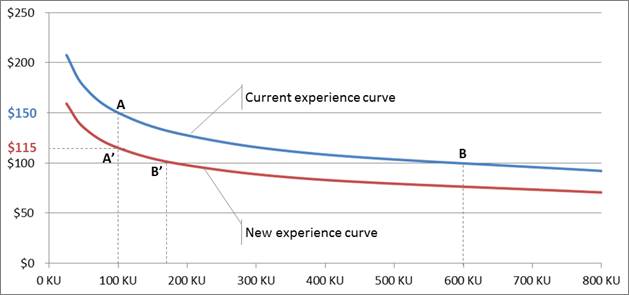
Manufacturing costs tend to decrease over time thanks to the experience effect. This is due to many factors such as increase in labor efficiency (fewer mistakes are made), improvement of methodologies & processes, use of new and fewer expensive materials and/or technologies and product redesign.
Experience effect should not be confused with economies of scale (the fact that manufacturing costs decrease with the size of the plant). Indeed, large plants amortize fixed costs on larger production batches; they have a higher negotiation or lobbying power; include machines of varying sizes and speeds (ensuring higher usage ratio); other cost reduction factors include transportation in big containers or access to less expensive financing. As the Marketing department is not responsible for production capacity, you are not concerned with economies of scale.
Hence, one way to reduce manufacturing costs is simply to produce more units of the same product. On average, it is estimated that manufacturing costs decrease by 15% each time cumulative production is doubled. This is represented by the blue curve on Figure 7: point A represents the base cost that was specified when the base project was developed and point B represents the transfer cost a few periods later, when cumulative production reached 600,000 units. The unit cost of this brand decreased from $150 to $100 (a 33% reduction). Unfortunately, the slope of the curve decreases quite rapidly: the additional production necessary to get an additional 15% reduction in unit cost gets bigger and bigger.
Firms can further reduce manufacturing costs by launching a cost reduction R&D project, i.e. a project specifying the same physical characteristics as the initial project, but at a lower base cost. This is represented by the red curve on Figure 7. Although the unit cost will initially be higher than $100 (point A’), the curve shows that transfer costs below $100 will be obtained as soon as cumulative production goes beyond point B’. Then, the transfer costs will be much lower than the ones achievable by the original blue curve.
Finally, one should not forget that costs will be adjusted for inflation; this will offset part of the reduction obtained through experience.

Figure 7 – Productivity gains